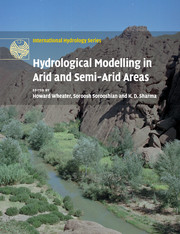Book contents
- Frontmatter
- Contents
- List of contributors
- Preface
- Acknowledgements
- 1 Modelling hydrological processes in arid and semi-arid areas: an introduction
- 2 Global precipitation estimation from satellite imagery using artificial neural networks
- 3 Modelling semi-arid and arid hydrology and water resources: The southern Africa experience
- 4 Use of the IHACRES rainfall-runoff model in arid and semi-arid regions
- 5 KINEROS2 and the AGWA modelling Framework
- 6 Ephemeral flow and sediment delivery modelling in the Indian arid zone
- 7 The modular modelling system (MMS): a toolbox for water and environmental resources management
- 8 Calibration, uncertainty, and regional analysis of conceptual rainfall-runoff models
- 9 Real-time flow forecasting
- 10 Real-time flood forecasting: Indian experience
- 11 Groundwater modelling in hard-rock terrain in semi-arid areas: experience from India
- Appendix Access to software and data products
- Index
- Plate section
- References
11 - Groundwater modelling in hard-rock terrain in semi-arid areas: experience from India
Published online by Cambridge University Press: 15 December 2009
- Frontmatter
- Contents
- List of contributors
- Preface
- Acknowledgements
- 1 Modelling hydrological processes in arid and semi-arid areas: an introduction
- 2 Global precipitation estimation from satellite imagery using artificial neural networks
- 3 Modelling semi-arid and arid hydrology and water resources: The southern Africa experience
- 4 Use of the IHACRES rainfall-runoff model in arid and semi-arid regions
- 5 KINEROS2 and the AGWA modelling Framework
- 6 Ephemeral flow and sediment delivery modelling in the Indian arid zone
- 7 The modular modelling system (MMS): a toolbox for water and environmental resources management
- 8 Calibration, uncertainty, and regional analysis of conceptual rainfall-runoff models
- 9 Real-time flow forecasting
- 10 Real-time flood forecasting: Indian experience
- 11 Groundwater modelling in hard-rock terrain in semi-arid areas: experience from India
- Appendix Access to software and data products
- Index
- Plate section
- References
Summary
INTRODUCTION
Across the world, the concern for water resources is growing as a result of population growth, climate change, and alarming signs that in some areas of the world, groundwater resources are being depleted at an unsustainable rate. This has prompted a re-examination of the world's water resources and the relationship between water and the environment. According to a United Nations survey, scarcity of fresh water is, in some areas, considered to be the world's most pressing concern (UN, 1987; El-Shibini and El-Kady, 2002). In many countries, to meet the increased demand for water, groundwater resources must be tapped. However, to ensure sustainability, much greater emphasis must be put on groundwater management than on exploration for new groundwater resources, as most productive aquifers have already been identified. Groundwater is particularly important in arid and semi-arid regions that lack perennial sources of surface water due to low rainfall and high evapotranspiration. This article focuses on groundwater management in hard-rock areas in semi-arid climates, where aquifers exist in the upper weathered-fissured section of the system; these aquifers receive little recharge, and have different and more complex characteristics than in classical sedimentary media. Specialized techniques are thus required to characterize and manage them.
Groundwater modelling has produced answers to many difficult questions that arise in the course of hydrogeological investigations. At present, it has become an indispensable tool in understanding and effectively managing aquifer systems.
- Type
- Chapter
- Information
- Hydrological Modelling in Arid and Semi-Arid Areas , pp. 157 - 190Publisher: Cambridge University PressPrint publication year: 2007
References
- 5
- Cited by

